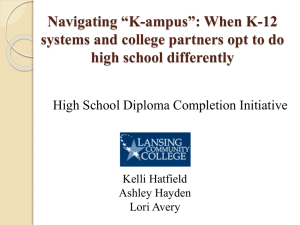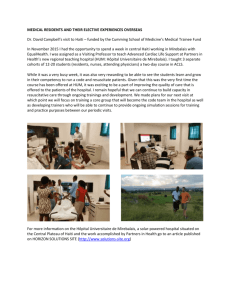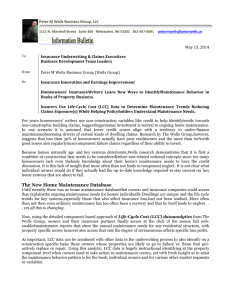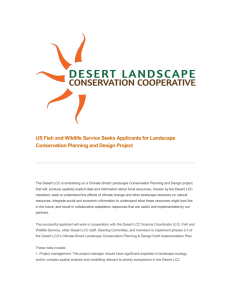sample classification paper (new window)
advertisement
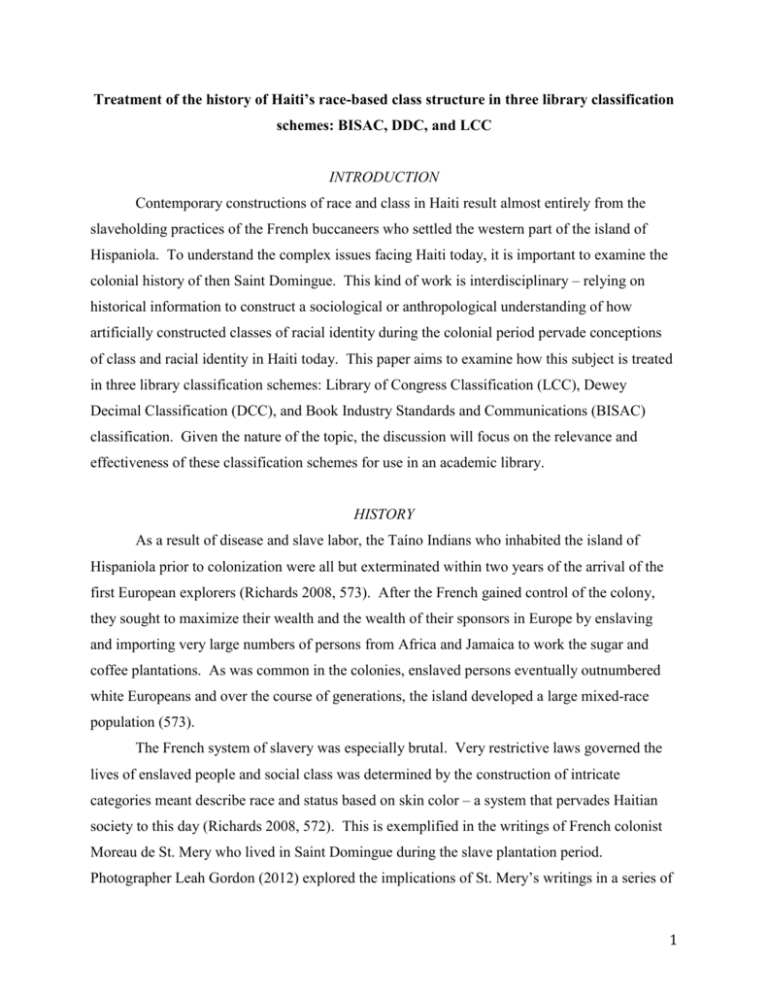
Treatment of the history of Haiti’s race-based class structure in three library classification schemes: BISAC, DDC, and LCC INTRODUCTION Contemporary constructions of race and class in Haiti result almost entirely from the slaveholding practices of the French buccaneers who settled the western part of the island of Hispaniola. To understand the complex issues facing Haiti today, it is important to examine the colonial history of then Saint Domingue. This kind of work is interdisciplinary – relying on historical information to construct a sociological or anthropological understanding of how artificially constructed classes of racial identity during the colonial period pervade conceptions of class and racial identity in Haiti today. This paper aims to examine how this subject is treated in three library classification schemes: Library of Congress Classification (LCC), Dewey Decimal Classification (DCC), and Book Industry Standards and Communications (BISAC) classification. Given the nature of the topic, the discussion will focus on the relevance and effectiveness of these classification schemes for use in an academic library. HISTORY As a result of disease and slave labor, the Taíno Indians who inhabited the island of Hispaniola prior to colonization were all but exterminated within two years of the arrival of the first European explorers (Richards 2008, 573). After the French gained control of the colony, they sought to maximize their wealth and the wealth of their sponsors in Europe by enslaving and importing very large numbers of persons from Africa and Jamaica to work the sugar and coffee plantations. As was common in the colonies, enslaved persons eventually outnumbered white Europeans and over the course of generations, the island developed a large mixed-race population (573). The French system of slavery was especially brutal. Very restrictive laws governed the lives of enslaved people and social class was determined by the construction of intricate categories meant describe race and status based on skin color – a system that pervades Haitian society to this day (Richards 2008, 572). This is exemplified in the writings of French colonist Moreau de St. Mery who lived in Saint Domingue during the slave plantation period. Photographer Leah Gordon (2012) explored the implications of St. Mery’s writings in a series of 1 photographs that were exhibited in London’s Riflemaker Gallery. She writes, “St. Mery created a surreal taxonomy of race classifying the skin color of the colony's population, where white, or Blanche was inevitably socially superior to black, or Noir. Using names borrowed from mythology, natural history and bestial miscegenation, St Mery classified nine degrees of shading, from pure black to 1/8 white, and 7/8 black and so on through Socatra, Griffe, Marabou, Mulâtre, Mamelouque, Quarteronné and Sang-Mêlé to White.” When word of social developments in France concerning the recognition of the “unalienable rights of man” spread to the colonies, existing unrest in the social hierarchy was ignited, culminating in what is considered the only slave revolt to result in the formation of a state – The Haitian Revolution (Richards 2008, 574). This is, of course, a simplification. In the struggle for control following the revolt “…the mulattos, considered as middle class by means of skin color…”gunned against the French, who recruited black slaves to their army, fueling resentments between racial groups (574). As Richards (2008) quite succinctly puts it, “War would permanently instill racial stereotypes and mistrust between the races, and history would show the effects of colonialism to have long-lasting implications for the quality of life of the Haitian people.” (6). CLASSIFICATION SCHEMES To explore the treatment of this subject in three classification schemes, it first needs to be conceptualized in subject headings. It may be possible to understand this “taxonomy of race” as a caste system. Richards, Gordon, and others (Lobb 1940) have indeed conceptualized it this way, thus leaving us with “Caste -- Haiti -- History” using Library of Congress Subject Headings (LCSH). However, according to the Penguin Dictionary of Psychology (2009), “Some authors restrict the term [caste] to the formal system in India, others use it for any such rigid stratification system.” To be on the safe side, we will use the less specific “Social classes -- Haiti -- History”. From here we take a social sciences approach, beginning with a study of social stratification systems and classes to which we then append notation signifying a specific place – Haiti – and an historical element. BISAC 2 BISAC is a classification standard used at many levels in the book industry supply chain to categorize books based on their subject. It has taken root in some libraries, generally public libraries, often because librarians feel that DDC and LCC are antiquated and fail to be adequately user-centric (Higgins 2012, 254). BISAC, as a system designed to market books in a retail setting, is thought to be more browse-able and user-friendly. The system is composed of a set of 51 very general subject headings, which further subdivide into more specific topics. For our purposes, we could look under History and find HISTORY/Caribbean & West Indies/General. Since the headings don’t subdivide beyond this point, we are left shelving items related to this topic in a very nonspecific way. The only historical category that names a specific country in the Caribbean & West Indies is HISTORY/Caribbean & West Indies/Cuba, which might suggest a bit of national bias. Because of the contemporary history of relations between the United States and Cuba, the country seems to warrant its own heading. If we take another approach, starting with Social Science, we come to SOCIAL SCIENCE/Discrimination & Race Relations. This more or less gets at the core issue, but it leaves out any element of place or history. Farther down we arrive at SOCIAL SCIENCE/Social Classes, which is closer to where we want to be (although in this case the issue of race is important). Again, we lack place or history. In sum, the very thing that makes BISAC appealing in some libraries is what makes it inadequate in this case. The simplicity of its subject headings renders it impossible to describe complex subjects. As Martínez-Ávila et al. (2013) put it in a paraphrasing of Sanford G. Thatcher, BISAC “…might not work very well for academic books at all,” (150). Dewey Decimal Classification (DDC) Devised by Melvil Dewey in 1873, DDC is a hierarchical classification scheme comprised of ten main classes that, it is supposed, “cover the world of knowledge” (OCLC 2014). These subdivide into 10 divisions, which further subdivide into 10 sections. Decimal notation makes it possible to build even more specific, if unwieldy, classification numbers. DDC instructs that when dealing with the history of a specific subject, the item should be classed under the subject itself (OCLC 2014, 4). In our case, we can begin at the main class 300 – Social Sciences. From there, we construct 3 302-307 Specific topics in sociology and anthropology 305 Groups of people At this point we could choose to go with 305.5 for People by social and economic levels or 305.8 for Ethnic and national groups. Regarding the latter number, WebDewey (2014) instructs, “Class here … race relations; racial groups, racism; treatment of biculturalism and multiculturalism in which difference in language is not a central element.” This leaves us with 305.8 Ethnic and national groups From the tables we append 009 for “Historical and geographic treatment” and 7294 for Haiti (Web Dewey 2014). Our final number reads: 305.80097294 Ethnic & national groups -- Haiti Elements of discrimination, social hierarchies, and history are not made explicit by the subject headings generated in WebDewey. This brings to mind one critique of DDC: that people are often not “purposive readers” (Martínez-Ávila et al. 2014, 150). If a person doesn’t know exactly what they are looking for, this may inhibit them from coming across what they need. This approach collocates books on our subject amongst other books discussing features of ethnic and national groups in Haiti, which is nested in a collocation of books on this topic in the West Indies and so on. If your search is primarily concerned with this specific aspect of societies, the collocation serves your purpose. However, if you are searching more broadly into the topic of Haiti’s history, you could potentially miss texts on this crucial facet of the country’s past. Library of Congress Classification (LCC) As Higgins (2012) reminds us, LCC was developed to meet the needs of the Congress it serves (250). It was concocted “…as a shelving device in response to the significant growth in book acquisition during the late nineteenth century…” (251). Like Dewey, the Library of Congress Classification & Shelflisting Manual (CSM) (2013) instructs that an item should be classed according to its subject matter. Since our original subject headings were taken from 4 LCSH, we would expect a stricter correlation in LCC between the subject we are describing and its call number. In LCC, we find the subject Social classes in the range HT601 – HT1455, where it is subdivided by very general categories. A visit to the HT (the broad class number for Communities, classes, and races) reveals that there is no subdivision for class on the basis of race. Indeed, race and class are on the same level within the hierarchy, without any clear way to denote classes based on race. This is a common critique of LCC because it means that class numbers fail to represent complex subjects (Higgins 2012, 254). Under HT601-HT1455 Classes, the LCC cataloging tool, Classification Web, apprises us that the subject of classes by region or country should be sought under HN50-981, the heading for Social history and conditions. Social problems. Social reform—By region or country, where we construct this class number: HN215.2.S6 The hierarchy looks like this: Social history and conditions. Social problems. Social reform. By region or country. Other regions or countries. Latin America. West Indies. Caribbean area. Haiti. Looking back to our original subject, the history of race-based class in Haiti, we can see that this doesn’t quite hit the mark. The notion of social conflict and animosity between groups of people is suggested by the term “Social problems”, but the specific nature of these groups is left vague. The country, Haiti, and the element of history are explicit. However, compared to DCC, a greater complexity is achieved with LCC. BISAC doesn’t come close to either of them as it can only really describe one subject at a time. Based on our exploration of this subject, we 5 can conclude that LCC is best suited to our needs in an academic library, where many of the items in the collection would be interdisciplinary and topically complex. DISCUSSION As our exploration indicates, all three of these classification schemes struggle with complexity, a major problem in academic libraries where most books cover complex subjects. LCC seems most sufficient of the three, but it is not immune to the problem, nor is it free from other shortcomings. Namely, as many authors have pointed out, the scheme reflects the bias of the 19th century, U.S.-centric attitude and worldview that gave rise to it (Higgins 2012; Idrees 2012; Drabinski 2013). This might also explain why complex class systems based on race in countries like Haiti are not as well developed within the scheme as are social class and race relations as they pertain to the United States. As to the challenge presented by complex subjects, this is one faced by all enumerative and hierarchical schemes that tend to be “strangled by their notations” (Higgins 2012, 255). LCC succeeds over DCC in this respect because alphanumeric notations provide for more possibility than strictly numeric ones (255). Still, it does not collocate books on either broad interdisciplinary subjects or very specific complex subjects. Higgins (2012) uses the example of a student searching for books on Marx, which can be found scattered under philosophy, economics, and politics (254). Books on our particular subject might be found under history, politics, economics, sociology, or anthropology. It also presents problems for very general topics, which is one reason some public libraries are experimenting with BISAC. To again use Higgins’ (2012) example, books on “flowers” would be scattered throughout “botany, art, courting rituals…” (254). Concerning the issue of bias, Idrees (2012) points out that the standard classification schemes, LCC included, are insufficient for cataloging collections on Islamic knowledge because they suffer from “western bias” (174). Idrees notes that while their devisors’ biases and interests play a part in explaining this, it is also possible that they simply lack an understanding of topics in Islamic knowledge or failed to understand that these standards would be adopted worldwide (179). In the case of LCC, it goes without saying that its devisors lacked an adequate understanding of Islamic topics. It is not at all surprising to think that ideological and religious 6 prejudice also plays a part, as well. As for whether or not they knew the system would be used throughout the globe, probably not in the beginning. As mentioned earlier, the scheme was designed for a very specific and localized purpose. Drabinski (2013) asserts that “…librarians have convincingly made the case that Library of Congress Classification (LCC) and Library of Congress Subject Headings (LCSH) fail to accurately and respectfully organize library materials about social groups and identities that lack social and political power,” (95). However, she argues that working to correct these biases is the wrong approach. Instead Drabinski suggests that any effort to describe “entire fields of knowledge or ways of being in accordance with universalizing systems and structures…invariably cannot account for knowledges or ways of being that are excess to and discursively produced by those systems,” (96). In other words, the act of trying to adapt LCC and LCSH to accommodate various identities and areas of knowledge defines some forms of knowledge and ways of being as acceptable and necessarily excludes others. The biases and notational limitations of LCC and DCC were part of the motivation behind the creation of faceted schemes such as Ranganathan’s Colon Classification (CC) in the late 1920s. Ranganathan believed that all knowledge is comprised of some very basic elements that could be combined in specific ways to create numbers rather that being limited by a list of predetermined classes (Satija and Singh 2013, 266). The scheme’s flexibility comes from its wide notational base, however this is also what makes it very complex (268). In effect, CC trades notational brevity and simplicity for the ability to accurately describe many forms of knowledge, experience, and identity, a fact that likely explains why it has not been maintained or become widely adopted even though it has tangible benefits. Despite the issues discovered in our examination of LCC and the fact that these problems are extensively discussed in the literature, the reasons for its nearly global ubiquity are simple. It is consistently maintained, relatively easy to understand, and economical (Higgins 2012, 252). Regarding this last reason, the availability of preprinted catalog cards proved more cost-effective for libraries over hiring catalogers to handle the entirety of that library’s collection, which worked in LCC’s favor and created increased opportunities for interoperability between libraries. This, in turn, made LCC more appealing and it was adopted by increasing numbers of libraries (253). CONCLUSION 7 In this examination of how our subject, the history of race-based class systems in Haiti, is treated in three library classification schemes, we have found that all three schemes suffer from shortcomings when it comes to handling complex subjects. Of the three, BISAC is the worst off and LCC handles the topic with the most grace, though far from perfectly. Additionally, all three schemes are limited in their ability to describe materials related to nonwestern forms of knowledge and “identities that lack social and political power,” (Drabinski 2013, 95), which at least partly explains why it is difficult to conceptualize an understanding of complex issues of race and social class in Haiti using these schemes. REFERENCES Drabinski, Emily. 2013. “Queering the Catalog: Queer Theory and the Politics of Correction.” The Library Quarterly 8 (2): 94 – 111. Accessed February 12, 2014. http://www.jstor.org/stable/10.1086/669547. Gordon, Leah. 2012. “Leah Gordon: ‘Caste’ The Nine Degrees of Skin Color.” The HuffPost Exposure Blog. Accessed February 19, 2014. http://www.huffingtonpost.com/evelynepolitanoff/leah-gordon-caste-the-9-d_b_1644250.html. Higgins, Colin. 2012. “Library of Congress Classification: Teddy Roosevelt’s World in Numbers?” Cataloging & Classification Quarterly 50 (4): 249-262. Accessed February 15, 2014. DOI: 10.1080/01639374.2012.658989. Idrees. 2012. “Library Classification Systems and Organization of Islamic Knowledge: Current Global Scenario and Optimal Solution.” Library Resources and Technical Services 56 (3): 171-182. Accessed February 13, 2014. http://go.galegroup.com.pitt.idm.oclc.org/ps/i.do?id=GALE%7CA296045310&v=2.1&u=upitt_main &it=r&p=AONE&sw=w&asid=0d9868d8f82377bf1baa6d5de9c34f5b. Library of Congress. 2013. “F10 General Principles of Classification.” Classification and Shelflisting Manual. Accessed via Cataloger’s Desktop February 23, 2014. https://desktop.loc.gov/saved/scmclsl_F_10_sec._6. Lobb, John. 1940. “Caste and class in Haiti.” American Journal of Sociology 46 (1): 23-34. Accessed February 20, 2014. http://www.jstor.org/stable/2769747. Martínez-Ávila, Daniel et al. 2014. “The Use of BISAC in Libraries as New Cases of ReaderInterest Classifications.” Cataloging and Classification Quarterly, 52: 137-155. Accessed February 12, 2014. DOI: 10.1080/01639374.2013.846284. 8 OCLC. 2014. “A Brief Introduction to the Dewey Decimal Classification.” Accessed February 20. http://www.oclc.org/dewey/resources/summaries.en.html#dev. OCLC. 2014. “Introduction to the Dewey Decimal Classification.” Accessed via WebDewey February 23. http://www.oclc.org/content/dam/oclc/dewey/versions/print/intro.pdf. Reber, Arthur S. et al. 2009. “Caste.” The penguin dictionary of psychology. New York: Penguin. Accessed February 20, 2014. http://search.credoreference.com.pitt.idm.oclc.org/content/title/penguinpsyc?tab=ove rview. Richards, C. Centae. 2008. “Haiti.” In Encyclopedia of Race, Ethnicity, and Society, edited by Schaefer, Richard T., 572-73. Thousand Oaks: Sage Publications, Inc. Accessed February 20, 2014. DOI: http://dx.doi.org/10.4135/9781412963879.n232. Satija, M.P. and Jagtar Singh. 2013. “Colon Classification: A Requiem.” Journal of Library & Information Technology 33 (4): 265-276. Accessed February 12, 2014. http://www.publications.drdo.gov.in/ojs/index.php/djlit/article/viewFile/4881/2839. 9


